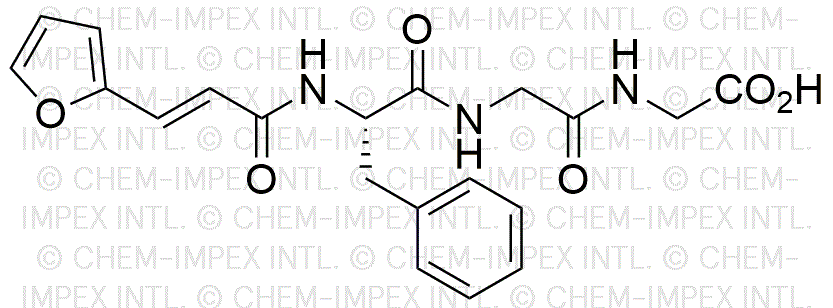FA-Phe-Gly-Gly-OH is widely utilized in research focused on:
- Peptide Synthesis: This compound serves as a building block in the synthesis of peptides, which are essential in drug development and biological research.
- Drug Delivery Systems: Its unique structure allows for the formulation of targeted drug delivery systems, improving the efficacy of therapeutic agents in treating diseases.
- Biochemical Assays: Researchers use it in various biochemical assays to study protein interactions and enzyme activities, providing insights into cellular processes.
- Cosmetic Formulations: The compound is incorporated into skincare products for its potential anti-aging properties, enhancing skin hydration and elasticity.
- Research on Neuroprotective Agents: It is being explored for its potential neuroprotective effects, making it relevant in studies related to neurodegenerative diseases.
General Information
Properties
Safety and Regulations
Applications
FA-Phe-Gly-Gly-OH is widely utilized in research focused on:
- Peptide Synthesis: This compound serves as a building block in the synthesis of peptides, which are essential in drug development and biological research.
- Drug Delivery Systems: Its unique structure allows for the formulation of targeted drug delivery systems, improving the efficacy of therapeutic agents in treating diseases.
- Biochemical Assays: Researchers use it in various biochemical assays to study protein interactions and enzyme activities, providing insights into cellular processes.
- Cosmetic Formulations: The compound is incorporated into skincare products for its potential anti-aging properties, enhancing skin hydration and elasticity.
- Research on Neuroprotective Agents: It is being explored for its potential neuroprotective effects, making it relevant in studies related to neurodegenerative diseases.
Documents
Safety Data Sheets (SDS)
The SDS provides comprehensive safety information on handling, storage, and disposal of the product.
Product Specification (PS)
The PS provides a comprehensive breakdown of the product’s properties, including chemical composition, physical state, purity, and storage requirements. It also details acceptable quality ranges and the product's intended applications.
Certificates of Analysis (COA)
Search for Certificates of Analysis (COA) by entering the products Lot Number. Lot and Batch Numbers can be found on a product’s label following the words ‘Lot’ or ‘Batch’.
Numéro de catalogue
Numéro de lot/série
Certificates Of Origin (COO)
This COO confirms the country where the product was manufactured, and also details the materials and components used in it and whether it is derived from natural, synthetic, or other specific sources. This certificate may be required for customs, trade, and regulatory compliance.
Numéro de catalogue
Numéro de lot/série
Safety Data Sheets (SDS)
The SDS provides comprehensive safety information on handling, storage, and disposal of the product.
DownloadProduct Specification (PS)
The PS provides a comprehensive breakdown of the product’s properties, including chemical composition, physical state, purity, and storage requirements. It also details acceptable quality ranges and the product's intended applications.
DownloadCertificates of Analysis (COA)
Search for Certificates of Analysis (COA) by entering the products Lot Number. Lot and Batch Numbers can be found on a product’s label following the words ‘Lot’ or ‘Batch’.
Numéro de catalogue
Numéro de lot/série
Certificates Of Origin (COO)
This COO confirms the country where the product was manufactured, and also details the materials and components used in it and whether it is derived from natural, synthetic, or other specific sources. This certificate may be required for customs, trade, and regulatory compliance.

